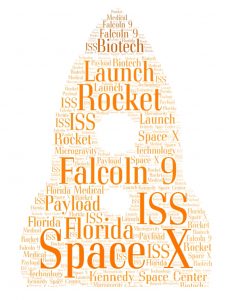
Living on the Space Coast as we call it on the Central Florida East Coast, we have become accustomed to watching launches over the ocean from time to time. What is intriguing for me is to read with interest about the payloads that are aboard, for example, the Space X Falcoln 9 which is set to launch this coming weekend and dock about 27 hours later with the International Space Station (“ISS”).
In a mission which launched on December 5, 2018, the payload included 20 different scientific experiments. One of the experiments was a tissue chip project designed by Sonja Schrepfer, a researcher from the University of California, San Francisco. Schrepfer’s investigation aims to measure the impacts of microgravity on the human immune system. NIH has also worked in the past with the ISS to secure space for several tissue chip projects. By creating the right environment, the cells behave like specific human tissues and even whole organs, which is much simpler, cheaper and more efficient to study. Pharma is very interested because they could potentially test the effect of drugs on different tissue types and organs.
Also aboard the December 5, 2018 mission was an experiment designed to test the efficacy of a wound-healing technology developed by Elaine Horn-Ranney and her biomedical company Tympanogen. The space station’s microgravity environment allows precise measurements of the ability of her novel hydrogel to promote healing and fend off infection-causing bacteria. Microgravity is ideal for studying the properties of very thin layers.
Another experiment on the Space X December 5 mission, was designed by Budweiser and tested the effects of microgravity on steeping, germination and kilning, processes involved in malting barley. The results could help beer makers design barley varieties capable of withstanding more stressful growing conditions.
A further experiment included was designed by Nicole L. Wagner, a researcher at LambdaVision, and her experiment will help scientists better understand how protein-based retinal implants grow and form different shapes. Under microgravity, biomaterials are able to perform more like they would inside the body.
The upcoming launch scheduled for this weekend (which has approx. 80% of going off as of this writing) is not carrying scientific experiments, however, but rather, is the first time that the Space X “Crew Dragon” capsule will be deployed carrying a test dummy passenger wearing a customized spacesuit designed specifically by Space X which future passengers will wear. The Crew Dragon is the compartment that has been designed to take passengers into space to visit the ISS, potentially as early as July 2019.
According to https://www.theverge.com/2019/2/28/18239745/spacex-dragon-capsule-nasa-commercial-crew-falcon-9-launch-dm-1, “SpaceX’s Falcon 9 rocket is scheduled to take to the skies over Florida, propelling a gumdrop-shaped spacecraft to the International Space Station. The rocket’s payload is SpaceX’s new Crew Dragon capsule — the company’s very first vehicle designed to carry people to space. Though the capsule is meant for passengers, no one will be on board for this trip. That’s because this flight is, at heart, a test. The mission, called Demonstration-1 or DM-1, is meant to show NASA that the Crew Dragon is space-worthy and safe for future human crew members.”
Also according to the Verge article, “[w]hen NASA’s Space Shuttle stopped flying in 2011, the space agency lost its main method of sending its astronauts to the International Space Station. So ever since then, NASA has been buying seats on board Russia’s Soyuz spacecraft in order to get US astronauts and international partners to the ISS. It’s an expensive arrangement, costing NASA $81 million per seat. It’s also NASA’s only option at the moment. If the Soyuz were to stop operating for an extended period of time, NASA would have no way to get its people to space.
That’s why, over the last decade, NASA has been working on a way to get its astronauts back on American-made vehicles again. Through the Commercial Crew Program, NASA gave contracts to both SpaceX and Boeing, valued at $2.6 billion and $4.2 billion respectively, in order to partially fund the development of new vehicles that could ferry astronauts to and from the ISS. Ever since, Boeing has been working on its vehicle, the CST-100 Starliner, while SpaceX has been developing the Crew Dragon.”






